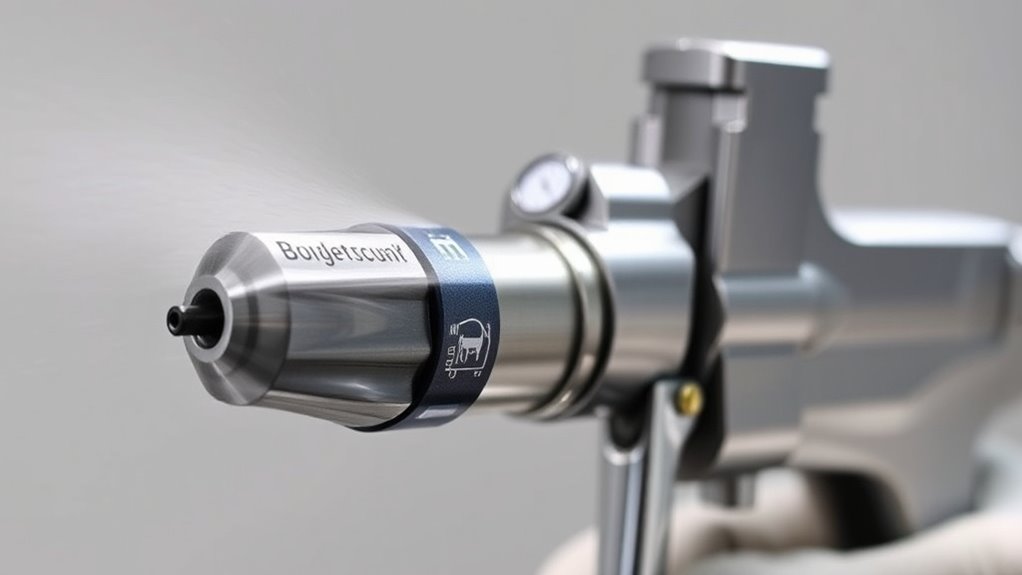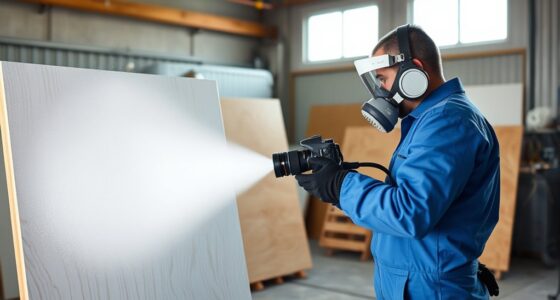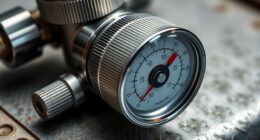To achieve a uniform coating with your spray gun, you need to master trigger control by applying consistent, gradual pressure. Keep your hand steady, use proper body positioning, and avoid jerky motions. Maintain a steady trigger speed and release gradually for even spray patterns. Adjust your nozzle and fluid flow for better control. If you keep practicing these techniques, you’ll get closer to a professional finish every time. More tips await to help refine your spray skills.
Key Takeaways
- Apply consistent, gradual trigger pressure to maintain an even spray pattern and prevent overspray.
- Keep a steady trigger speed, avoiding jerks or sudden releases for uniform coating.
- Use proper body positioning and a relaxed stance to enhance control and reduce fatigue.
- Practice smooth trigger motions and releases to develop muscle memory for consistent results.
- Regularly adjust nozzle and fluid controls to ensure even coverage and prevent uneven finishes.
Understanding the Importance of Trigger Control
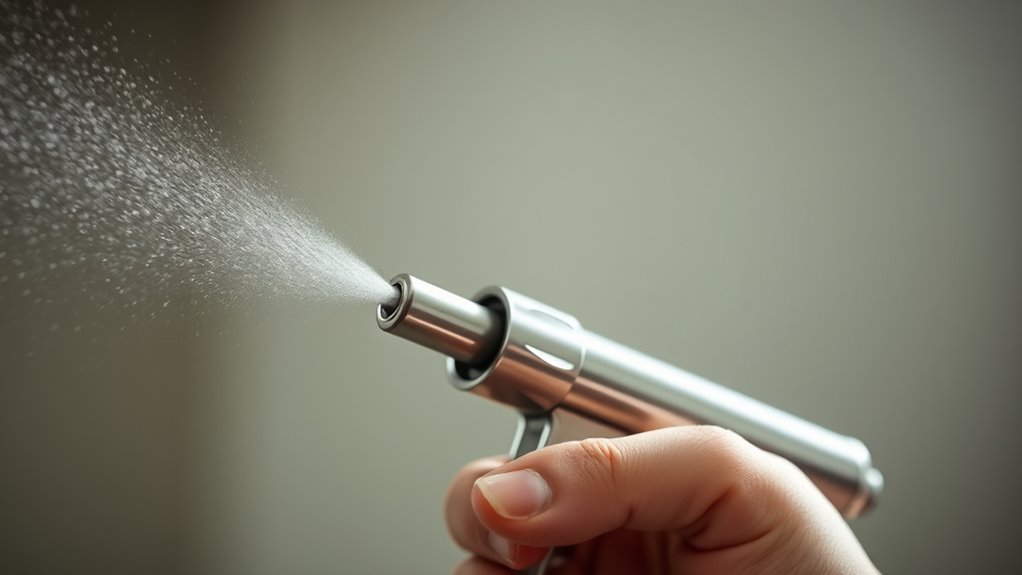
Understanding the importance of trigger control is essential for achieving a smooth, even spray and preventing costly mistakes. Proper trigger ergonomics allows you to maintain comfort and control during application, reducing fatigue that can lead to uneven coating. When you master trigger control, you ensure spray pattern consistency, which is vital for a professional finish. A steady trigger press helps you avoid overspray or uneven layers, saving material and time. By focusing on trigger ergonomics, you can develop a natural, comfortable motion that promotes uniform application. Consistent trigger pressure keeps your spray pattern steady, resulting in a more precise and high-quality finish. Remember, good trigger control isn’t just about technique; it’s about understanding how your grip and pressure impact the final result.
Preparing Your Spray Gun for Consistent Results
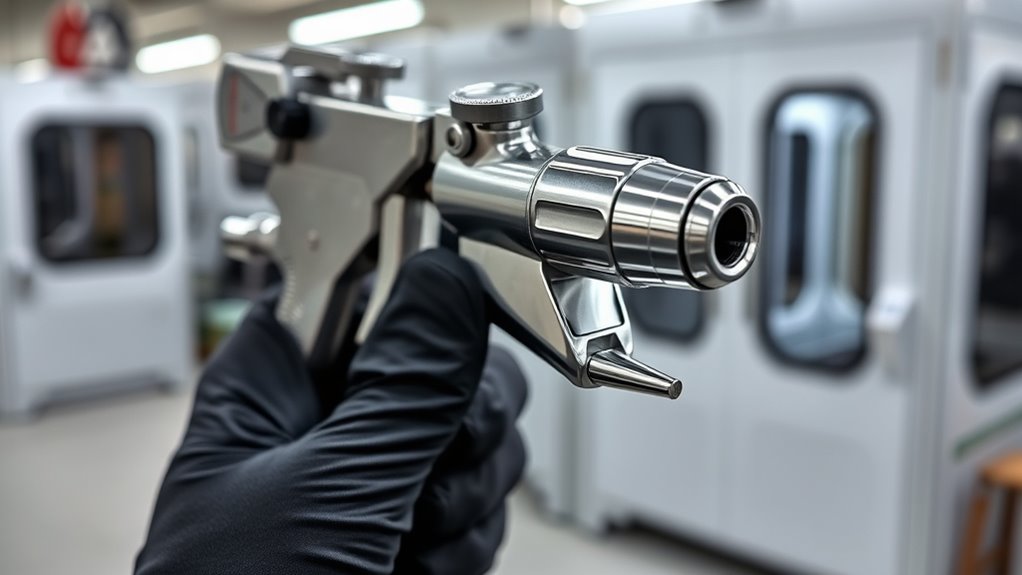
Preparing your spray gun properly sets the foundation for achieving consistent, high-quality finishes. First, ensure equipment calibration is correct; check fluid flow, air pressure, and nozzle size to match your project needs. Next, follow safety precautions—wear goggles, masks, and gloves, and work in a well-ventilated area to protect yourself from fumes and overspray. Finally, clean your spray gun thoroughly before use to prevent clogs and uneven coating. Regular calibration helps maintain uniform spray patterns, while proper safety measures keep you protected during operation. Taking these steps guarantees your spray gun performs reliably, resulting in smooth, even coatings every time. With a well-prepared gun, your trigger control becomes more effective, leading to professional-quality results.
Techniques for Smooth Trigger Pulls
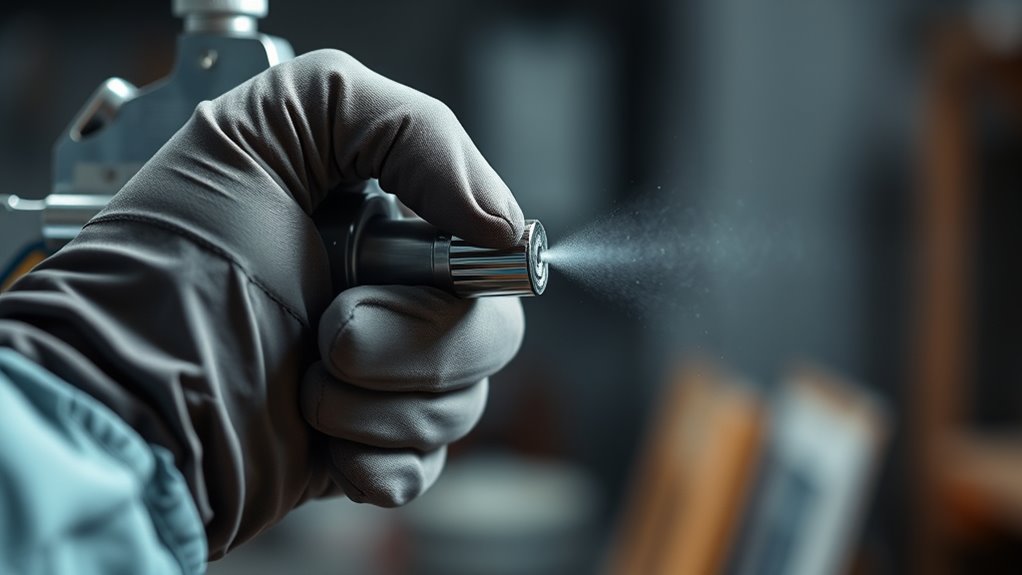
To achieve a flawless spray finish, mastering smooth trigger pulls is vital. Start by applying consistent pressure, avoiding sudden jerks that can lead to uneven coating or color mismatches. Practice gradual, steady pulls to maintain uniform paint flow, which is imperative for color matching and a professional look. Always follow safety precautions, such as wearing protective gear, to prevent inhalation of fumes and guarantee safe handling. Keep your finger relaxed on the trigger, focusing on a smooth, controlled motion from start to finish. This prevents overspray and uneven layers. Remember, a steady trigger pull results in even distribution, reducing touch-ups and achieving a more polished, uniform coating. Regular practice helps develop muscle memory for flawless, consistent results every time. Additionally, understanding spray gun trigger control can greatly improve your painting technique and final outcome. Being aware of trigger pull speed can also influence the quality of the finish by affecting paint atomization and flow rate. Moreover, paying attention to trigger pressure modulation can help fine-tune the amount of paint released during each pull, leading to more precise control.
Maintaining a Steady Hand and Proper Body Position
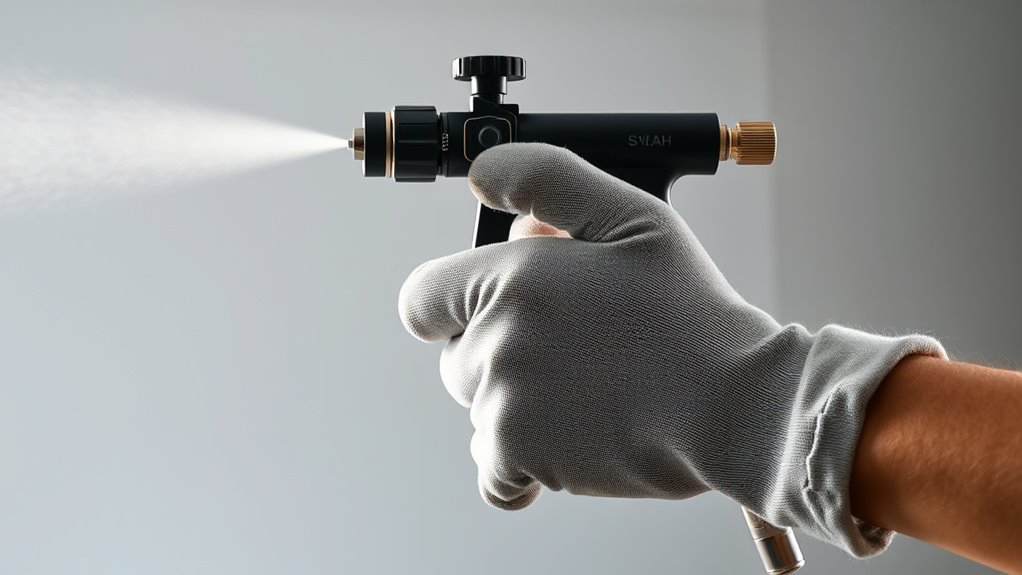
To keep your spray application smooth, you need to stabilize your stance and stay balanced. Keep your elbow bent to reduce fatigue and improve control. Consistently gripping the gun helps maintain steady movement and even coverage. Incorporating proper body positioning techniques can further enhance your spraying accuracy. Additionally, maintaining a steady hand through controlled breathing can significantly improve the uniformity of your coating. Practicing neural network based techniques can help optimize your spraying pattern over time. Developing muscle memory through regular practice can also lead to more consistent results. Ensuring your equipment is well-maintained and calibrated can also contribute to achieving a uniform coating.
Stabilize Your Stance
Keeping a steady hand while using a spray gun starts with your stance. Your posture awareness helps you stay balanced and reduces fatigue. To stabilize your stance:
- Keep your feet shoulder-width apart for a solid foundation.
- Maintain a slight bend in your knees to absorb movement.
- Align your body with the spray pattern, avoiding twisting.
- Incorporate proper posture techniques to further enhance control and comfort during spraying. Being aware of your security zone info can also help you stay focused and alert while working. Additionally, understanding how to blend elements seamlessly can improve your overall spray application, ensuring a more uniform coating. Remember to adjust your grip and body positioning to maintain precision throughout your work. Focus on your breathing techniques; steady, deep breaths keep you calm and prevent shaky hands. Keep your body relaxed, especially your shoulders and arms, to avoid tension that can cause uneven coating. A proper stance not only improves control but also minimizes fatigue over extended periods. Incorporating a balanced stance helps you maintain consistency and reduces strain during long sessions. Remember, a stable stance combined with conscious posture awareness makes a significant difference in achieving a smooth, uniform finish.
Keep Elbow Bent
Maintaining a slight bend in your elbow helps you control the spray gun more precisely. This position promotes elbow stability, reducing unwanted movement that can affect coating consistency. Keep your arm close to your body to improve arm positioning, which allows for smoother, more controlled strokes. A bent elbow acts as a hinge, giving you better leverage and preventing fatigue during extended spraying sessions. Focus on keeping your elbow steady and avoid locking it straight, which can cause jerky motion. Proper arm positioning also helps you maintain a consistent distance from the surface, ensuring even application. Remember, a relaxed, bent elbow creates a steady platform for your hand, making it easier to maintain a uniform coating. Additionally, practicing proper posture can help prevent strain and improve your technique, which is essential for achieving a professional finish. Incorporating body mechanics into your spray process can further enhance control and reduce fatigue over long sessions. Developing awareness of your body alignment can also contribute to more consistent results and reduce the risk of injury, much like the principles of existential authenticity encourage a genuine approach to personal actions.
Maintain Consistent Grip
A steady grip and proper body positioning are vital for consistent spray results. Your grip ergonomics influence how smoothly you operate the trigger and control trigger sensitivity. To maintain a consistent grip:
- Keep your hand relaxed but firm around the spray gun, avoiding unnecessary tension.
- Position your body so you’re balanced, with your wrist aligned naturally to minimize fatigue.
- Focus on applying even pressure on the trigger, using your fingers rather than your whole hand, to prevent fluctuations in spray pattern.
A secure yet comfortable grip ensures you control trigger sensitivity precisely, leading to uniform coatings. Proper body positioning reduces fatigue and helps maintain steady hand movements, so your spray pattern stays consistent from start to finish.
Practicing Trigger Speed and Release Timing
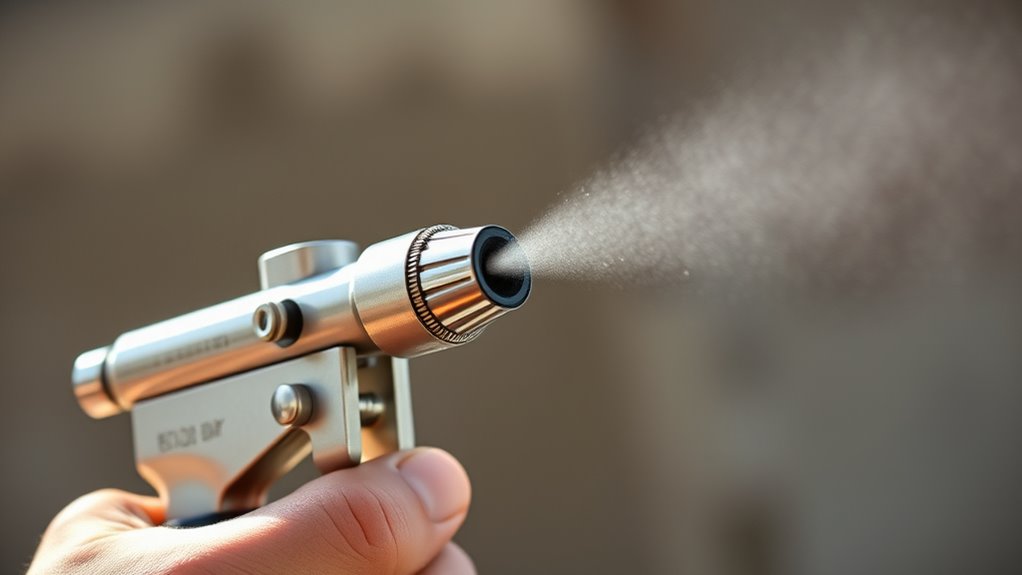
To improve your spray gun control, focus on practicing consistent trigger speed and precise release timing. These skills help you achieve better accuracy and a smoother finish. Regular practice will make these techniques second nature in your painting process, and paying attention to adjusting pressure can further enhance your spray pattern and overall results. Additionally, being mindful of your trigger patterns can help you develop a more controlled and even coating application. Monitoring paint viscosity can also ensure optimal spray performance and prevent issues like clogging or uneven application.
Consistent Trigger Speed
Have you ever noticed how inconsistent trigger speed can affect your spray gun’s performance? It can lead to uneven coats and color mixing issues. To improve, focus on maintaining a steady trigger pace. Here are three tips:
- Practice in front of a mirror to observe your trigger rhythm.
- Ensure your equipment calibration is accurate for consistent spray patterns.
- Develop a smooth, controlled trigger motion, avoiding sudden stops or starts.
Consistent trigger speed helps you achieve uniform coatings and better color mixing. When your trigger moves at the same speed, the spray pattern remains steady, reducing overspray and uneven layers. Remember, practicing regularly will help you develop muscle memory, making your trigger control more precise over time. Fine-tuning your trigger speed is key to professional-quality finishes.
Precise Release Timing
Mastering trigger release timing complements your steady trigger speed by ensuring you start and stop spray smoothly. Precise timing prevents uneven coats and reduces trigger finger fatigue caused by abrupt releases. Focus on practicing gentle, controlled releases that match your spray gun’s ergonomics. This helps you avoid unnecessary strain and maintains consistent coating quality. To stay motivated, visualize your ideal spray pattern and timing.
| Calm Control | Rapid Release |
|---|---|
| Smooth, steady motion | Jerky, inconsistent spray |
| Less trigger finger fatigue | Increased fatigue and strain |
| Better spray gun ergonomics | Discomfort and uneven coating |
Practice for Accuracy
Practicing trigger speed and release timing regularly helps you develop greater accuracy and muscle memory. Consistent practice ensures you can match colors precisely and maintain a smooth spray booth setup. To improve, focus on these key areas:
- Adjust your trigger speed to match the paint flow needed for even color matching, avoiding overspray or uneven coats.
- Practice releasing the trigger at the right moment, especially when transitioning between different sections or colors.
- Set up your spray booth properly and practice within that environment to simulate real conditions, helping you control trigger actions more accurately.
Adjusting Spray Pattern and Fluid Flow for Better Control
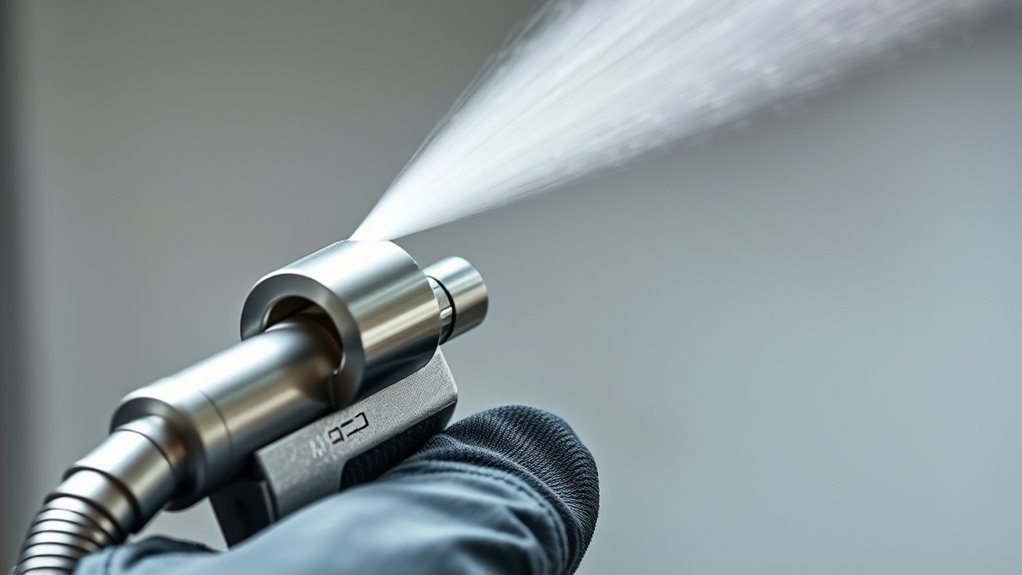
To achieve better control over your spray gun, you need to modify both the spray pattern and fluid flow. Proper spray pattern adjustment ensures even coverage, while fluid flow regulation controls the amount of coating material. Use the nozzle to alter the pattern’s width and shape, and tweak the fluid control valve to set the flow rate. This combination helps you avoid overspray and drips, resulting in a smooth, uniform finish.
| Spray Pattern Adjustment | Fluid Flow Regulation |
|---|---|
| Changes the shape/width | Controls the amount of material |
| Ensures even coverage | Prevents overspray |
| Improves control | Reduces waste |
| Adjusts for surface type | Maintains consistent finish |
Common Mistakes to Avoid When Triggering
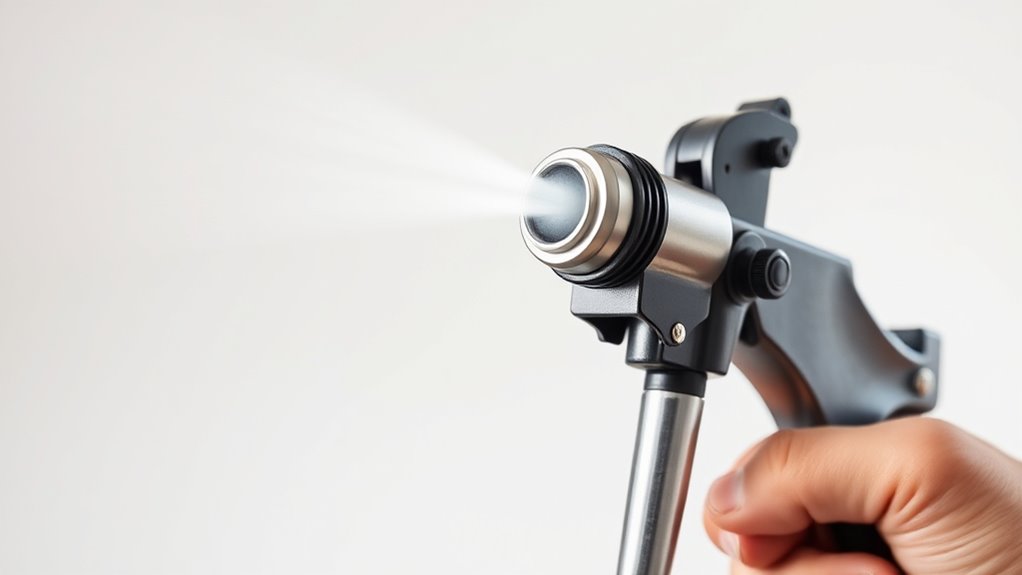
One common mistake when triggering your spray gun is applying too much pressure, which can cause uneven spray patterns and overspray. Overtriggering can lead to inconsistent coating and waste material. To avoid this, be mindful of your trigger control. Here are a few mistakes to watch out for:
Avoid applying too much pressure to maintain a consistent, professional spray finish.
- Overtriggering – Holding the trigger too long or pressing too hard, resulting in uneven coating.
- Inconsistent Trigger Speed – Moving your finger too quickly or slowly, creating an uneven spray.
- Triggering Too Early or Too Late – Starting or stopping the spray at the wrong moment, leading to thin or thick spots in the finish.
Staying aware of these common mistakes helps you maintain a steady, uniform spray pattern and achieve a professional finish.
Tips for Achieving Professional-Quality Finishes

Maintaining proper trigger control is key to achieving a professional-looking finish with your spray gun. To improve your results, ensure your spray booth setup is optimized for consistent airflow and proper ventilation, which helps achieve even application and better color matching. Keep your gun at a steady distance from the surface, typically around 6-12 inches, and use smooth, overlapping strokes to avoid streaks and uneven coating. Practice trigger modulation to control paint flow precisely, preventing runs or dry spots. Consistent trigger pressure during each pass guarantees uniform coverage and a smooth finish. Additionally, monitor your environment for temperature and humidity, as these factors impact the final appearance. With proper trigger control and setup, you’ll produce finishes that look professional and perfectly match your desired colors.
Frequently Asked Questions
How Do Environmental Conditions Affect Trigger Control?
Environmental factors, like humidity and temperature, markedly impact your trigger control during spraying. High humidity can cause the coating to dry too slowly, making it harder to maintain a steady trigger pull, while low humidity speeds up drying, risking uneven application. Good humidity control helps you maintain consistent trigger control, ensuring a smooth, uniform coating. Adjust your technique accordingly, especially in fluctuating environmental conditions, to achieve the best finish.
What Safety Precautions Should Be Taken During Spraying?
When spraying, you should always wear protective gear like masks, gloves, and goggles to prevent inhaling fumes or getting splattered. Make sure proper ventilation systems are in place to reduce airborne overspray and fumes, keeping the air clean and safe. Never bypass safety protocols, and always follow manufacturer instructions. These precautions protect you from health hazards and ensure a safer working environment during spraying activities.
Can Trigger Control Techniques Vary Between Different Spray Gun Types?
You might notice that trigger control techniques can differ between spray gun types because of variations in spray pattern and trigger ergonomics. For example, some guns require a gentle, steady trigger pull to achieve an even coat, while others might need quicker, more responsive actions. Understanding each gun’s trigger mechanics helps you maintain a consistent spray pattern, ensuring a smooth, uniform coating every time.
How Does Spray Distance Influence Trigger Timing?
You should understand that spray distance directly impacts trigger timing because holding the spray gun too close or too far affects how evenly you apply the coating. With a shorter spray distance, you might need to trigger earlier to prevent uneven coverage, while a longer distance requires more precise timing to avoid drips or overspray. Adjust your trigger timing based on your spray distance to achieve a smooth, uniform finish.
What Are the Signs of Inconsistent Trigger Control During Application?
When you have inconsistent trigger control, you may notice uneven coating, streaks, or excessive overspray. These signs often stem from trigger fatigue, causing you to press unevenly, or from poor equipment calibration, leading to inconsistent spray patterns. To improve, take regular breaks to prevent trigger fatigue and verify your equipment is properly calibrated. This helps you maintain steady trigger control, resulting in a uniform and professional finish.
Conclusion
Mastering your spray gun trigger control isn’t just a skill—it’s the secret to transforming your projects from amateurish drips to flawless masterpieces. With perfect trigger timing, steady hands, and precise adjustments, you’ll create finishes so smooth and even, they’ll make professionals cry with envy. Keep practicing, avoid common mistakes, and soon, you’ll wield your spray gun like a true artist—turning every coat into a breathtaking work of art that defies expectations!
